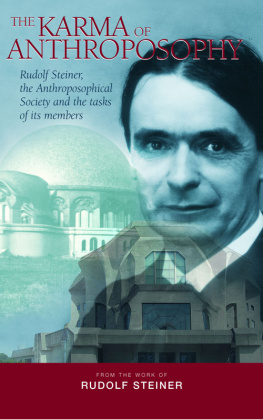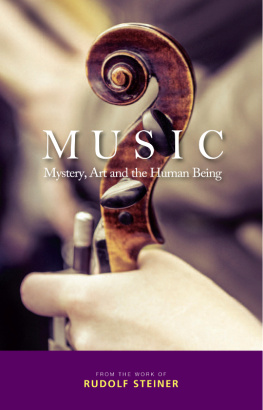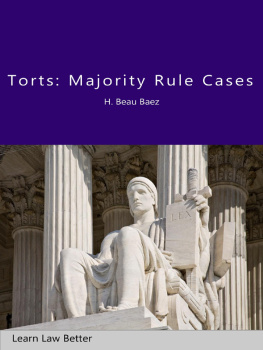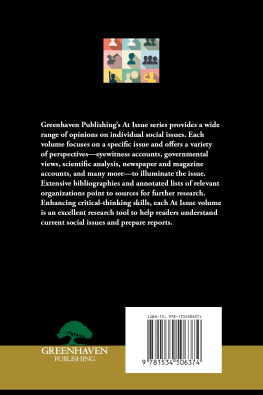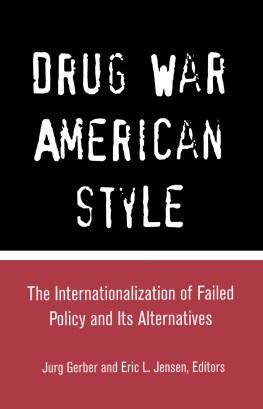Steiner Jurg - Amicable Agreement Versus Majority Rule
Here you can read online Steiner Jurg - Amicable Agreement Versus Majority Rule full text of the book (entire story) in english for free. Download pdf and epub, get meaning, cover and reviews about this ebook. year: 2018, publisher: University of North Carolina Press, genre: Politics. Description of the work, (preface) as well as reviews are available. Best literature library LitArk.com created for fans of good reading and offers a wide selection of genres:
Romance novel
Science fiction
Adventure
Detective
Science
History
Home and family
Prose
Art
Politics
Computer
Non-fiction
Religion
Business
Children
Humor
Choose a favorite category and find really read worthwhile books. Enjoy immersion in the world of imagination, feel the emotions of the characters or learn something new for yourself, make an fascinating discovery.

- Book:Amicable Agreement Versus Majority Rule
- Author:
- Publisher:University of North Carolina Press
- Genre:
- Year:2018
- Rating:5 / 5
- Favourites:Add to favourites
- Your mark:
- 100
- 1
- 2
- 3
- 4
- 5
Amicable Agreement Versus Majority Rule: summary, description and annotation
We offer to read an annotation, description, summary or preface (depends on what the author of the book "Amicable Agreement Versus Majority Rule" wrote himself). If you haven't found the necessary information about the book — write in the comments, we will try to find it.
Amicable Agreement Versus Majority Rule — read online for free the complete book (whole text) full work
Below is the text of the book, divided by pages. System saving the place of the last page read, allows you to conveniently read the book "Amicable Agreement Versus Majority Rule" online for free, without having to search again every time where you left off. Put a bookmark, and you can go to the page where you finished reading at any time.
Font size:
Interval:
Bookmark:
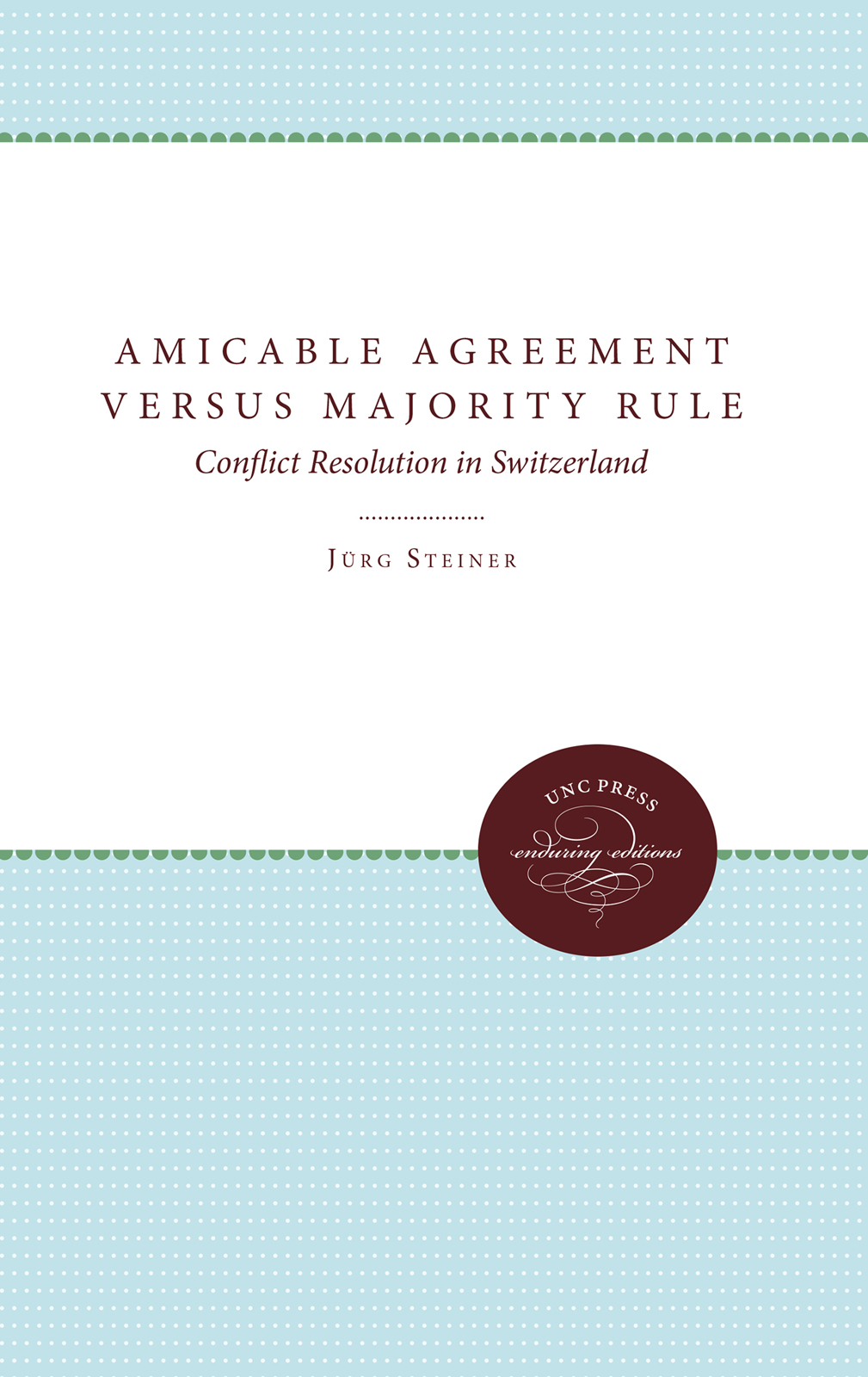
Originally published as
Gewaltlose Politik und kulturelle Vielfalt
Hypothesen entwickelt am Beispiel der Schweiz
Mit einem Vorwort von Stein Rokkan
German edition Copyright 1970 by Paul Haupt, Berne and Stuttgart
English edition Copyright 1974 by
The University of North Carolina Press
Manufactured in the United States of America
Library of Congress Catalog Card Number 73-4688
ISBN 0-8078-1214-5
Library of Congress Cataloging in Publication Data
Steiner, Jrg.
Amicable agreement versus majority rule.
Translation of Gewaltlose Politik und kulturelle Vielfalt.
1. SwitzerlandPolitics and government. 2. Political partiesSwitzerland. 3. Social groups. 4. Power (Social sciences) I. Title. JN8783.S7413 1973320.949473-4688 ISBN 0-8078-1214-5
To our children Beat, Markus, and Niklaus, who move back and forth between the Swiss and the American cultures. May they become world citizens.
Switzerland presents a microcosm of Europe: linguistic and religious diversities, regional contrasts in economic growth and in settlement patterns, stubbornly defended pockets of autonomy in a system of increasing interdependence and accelerated interdependence.
For all these reasons every serious study of the politics of Switzerland is a contribution to the study of the political structure of Europe. This goes for historical and institutional studies: it applies with even greater force to a systematic theoretical study such as Jrg Steiners. A number of descriptive studies have given us solid bodies of information about parts of the Swiss political system: Jrg Steiners is the first formal analysis of the crucial variables of the system, the first theory-oriented case study of Switzerland. One may quarrel with a number of hypotheses in this formal presentation and wish for a fuller exposition of the interlinkages among the variables: what is important is that Jrg Steiner has made this first attempt at a systematization of the available evidence for this one country. Other political scientists may prefer to present their analyses in a more conventional literary form: what is important is that Jrg Steiner has developed a scheme of variables and hypotheses which will inspire parallel case studies for other countries and possibly even direct cross-national comparisons.
As a theoretical case study Steiners work poses problems of research strategy surprisingly similar to those raised by Harry Ecksteins controversial study of my own country, Norway: how can we know where a country stands on the different variables without comparing it with another or others? What can we conclude from a single configuration of values on the given set of variables? Steiner grapples valiantly with these problems and shows how far it is possible to move in an in-depth study of a single country. He has one great advantage over Eckstein: even if he can adduce only very few and superficial comparisons with other countries of Europe he can compare the cantons with each other. Switzerland offers extraordinary opportunities for such intracountry comparisons and Steiner points to a number of concrete possibilities of this type. There is every reason to hope that he will push on further in this direction in the years to come. In developing my model for the explanation of variations in the growth of mass politics within western Europe I have again and again been struck by the possibilities of transposing the model to the level of the Swiss cantons. In reading Jrg Steiners book I have again been struck by these isomorphisms: Switzerland is a microcosm of Europe and anyone seeking to understand the structure and the dynamics of European politics will do well to immerse himself in this study by Jrg Steiner, both in the data and the evidence he has pulled together and in the general framework he has tried to construct.
STEIN ROKKAN
Yale University
New Haven, Conn.
March, 1970
S. Rokkan, Citizens, Elections, Parties (Oslo: Universitetsforlaget, 1970).
In preparing the English translation I have extensively revised the manuscript. Several reviews of the German version, especially those by Gerhard Lehmbruch and Henry H. Kerr, Jr., were of great help in the preparation of this revision. I have also learned much from discussions with Karl Deutsch, William Keech, Arend Lijphart, Val Lorwin, Duncan MacRae, Jr., Frank Munger, Jeffrey Obler, and Alan Stern. My special thanks go to Asger and Barbara Braendgaard for their translation.
I am grateful to the Swiss National Science Foundation for its support of most of the research on which this volume is based. My German publisher, Paul Haupt (Berne and Stuttgart), has charged nothing for his copyright. Without this friendly gesture an English translation would probably not have been possible.
JRG STEINER
Chapel Hill, N.C.
January, 1973
Switzerland is strongly segmented into subcultures, yet hostility among its subcultures is relatively low. This low hostility contrasts sharply with high levels of hostility in many other subculturally strongly segmented political systems. This study hopes to contribute to the explanation of these variations.
The theoretical universe of this study will consist of all political systems with strong subcultural segmentation. In attempting to explain the level of intersubcultural hostility in such systems, I will begin with as many hypotheses as I can find in the literature. I will use the national system of Switzerland and its subculturally strongly segmented cantons to test these hypotheses. On the basis of the empirical evidence I will develop an interlinked system of hypotheses. In a last step I will apply this theoretical model in a tentative way to the European Community.
All political systems are probably segmented into subcultures to a certain extent. Robert A. Dahl defines subcultures as distinctive sets of attitudes, opinions, and values that persist for relatively long periods of time in the life of a country and give individuals in a particular subculture a sense of identity that distinguishes them from individuals in other subcultures. In the present context I am interested only in political systems with strong subcultural segmentation. To determine the strength of subcultural segmentation, one must measure the intensity of self-identification of the different subcultures. Possible indicators are responses to attitudinal survey questions, frequency of interactions among the members of a subculture, and organizational ties within a subculture.
The concept of subcultural segmentation, as it is used here, is different from the concept of cultural diversity. By the latter I mean simply that the members of a political system differ with regard to cultural attributes that have a potential political relevance. The main attributes that I have in mind are language, religion, race, tribe, social class, and region. To measure the cultural diversity of a political system, the computation formula developed by Douglas W. Rae and Michael Taylor may be used.
Font size:
Interval:
Bookmark:
Similar books «Amicable Agreement Versus Majority Rule»
Look at similar books to Amicable Agreement Versus Majority Rule. We have selected literature similar in name and meaning in the hope of providing readers with more options to find new, interesting, not yet read works.
Discussion, reviews of the book Amicable Agreement Versus Majority Rule and just readers' own opinions. Leave your comments, write what you think about the work, its meaning or the main characters. Specify what exactly you liked and what you didn't like, and why you think so.

